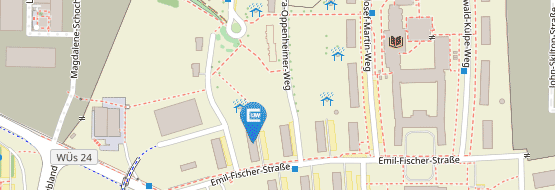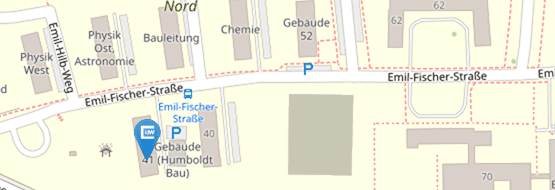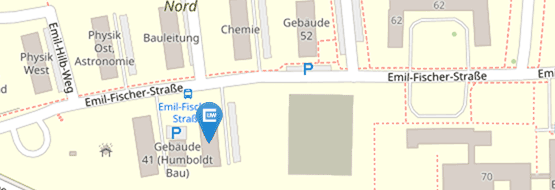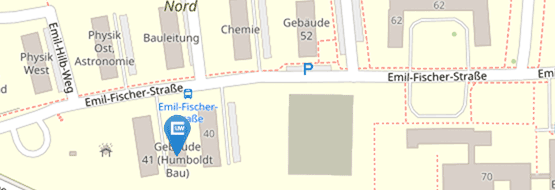Projects
The following list of projects gives an impression on the current topics of research at Chair X. With many of these topics a clear separation into single projects is not possible. Instead, aspects of other projects may play an important role as well.
Since in formal deformation quantization ℏ is only considered as formal parameter a physically reasonable theory needs to answer the questions of convergence. In general, this is a fairly difficult problem as it is known that a formal star product can definitely not converge for all smooth functions. Thus one needs to find a suitable subalgebra for which convergence is possible. On the one hand, this subalgebra should be small enough such that one has success with convergence. On the other hand, it should be as large as possible to contain all physically relevant observables. In this long-term project we try to find general constructions based on the detailed discussion of particular examples.
Contact: Stefan Waldmann
Star products have an additional algebraic structure of a *-involution given by complex conjugation. From a physical point of view this is of crucial importance since only with this *-involution the truly observable elements of the observable algebra can be characterized as the Hermitian elements. The *-involution is now important if one wants to represent the observable algebra by operators on a Hilbert space: one is looking for a *-representation. However, since the star products are formal power series in ℏ one needs to adapt the notion of a Hilbert space accordingly. Here we consider a purely algebraic framework of *-algebras over ordered rings and their *-representations on pre-Hilbert space over such rings. The algebras of deformation quantization form a large and non-trivial class of examples but one has further examples from other fields in pure mathematics and from quantum physics as well fitting this framework. In a second step we also consider the convergent star products and their representation theory by unbounded operators, now relying on standard Hilbert space techniques.
Contact: Stefan Waldmann
A classical question in algebra is what one can learn about a (non-commutative) ring if one knows its representation theory, i.e. the category of all its left modules. The answer is that two rings have the same representation theory if there is a certain bimodule between them having some particular features. In this case one calls the rings Morita equivalent. In the commutative case, Morita equivalence is nothing else than isomorphism. Nevertheless, also in this case it is interesting since one can consider the possible ways of how a ring can be Morita equivalent to itself. These self-equivalences form a group, the Picard group of the ring. In the commutative case it contains the automorphism group but can be strictly larger. The additional elements can have simple geometric interpretations in sufficiently nice situations. Our interest in Morita theory comes from the representation theory of observable algebras which arise as deformation quantizations of classical mechanical systems. Here a complete classification is available, current questions are on symmetry aspects and the compatibility with the classical limit.
Contact: Stefan Waldmann
For a classical system the presence of symmetries implies by Noether's Theorem corresponding conserved quantities. A conceptually clear formulation can be found in the notion of a momentum map. Fixing the conserved quantities on particular values leads to phase space reduction turning a high-dimensional phase space into a phase space of lower dimension which might then have a more complicated geometry. Since this a successful and important construction in classical theories one is also interested in analogs for the quantum side. In this long-term project we consider several constructions of phase space reduction of star products and investigate the properties of the resulting reduced star products. In addition, the behavior of the representation theories under phase space reduction is studied.
Contact: Stefan Waldmann
Star products deform the classical function algebra of a manifold into a non-commutative algebra. Since classically the differential geometric properties of the manifold are completely encoded in algebraic features of the functions one can now speak of a non-commutative manifold after deformation. This opens many new applications of deformation quantization namely non-commutative geometry.
We consider which other geometric structures one can deform once a star product is given. Of particular interest are vector bundles and more general bundles like principal fiber bundles since they are the foundations of any physical field theory. While vector bundles and principal fiber bundles can always be deformed as right modules and these deformations are even unique up to isomorphism, for more general geometric objects this is far from being clear. We also discuss the possibilities of having bimodule structures instead of just right modules. To approach these questions one needs the computation of certain cohomologies which describe the obstructions for deformations.
Moreover, one can also deform geometric structures on a classical level directly: a given geometric structure is deformed inside a family of structures of the same type. This way, one obtains statements on stability and rigidity. Here we discuss in particular various situations arising in Poisson geometry like the deformation of Morita bimodules between Poisson manifolds.
Contact: Stefan Waldmann
Since projective geometry has long played an important role in the field of computer vision, methods from differential geometry have been increasingly used in recent years to describe static and dynamic effects mathematically correct. The Riemannian manifolds that occur here are often of small dimension (<10) and thus also accessible to computer simulations. The development of algorithms and methods for efficient interpolation, optimization, control and data processing on the so-called essential manifold is in the foreground of this project.
Contact: Knut Hüper
Certain quantum field theories can be described mathematically exactly. Among these, a well-studied class of examples are topological quantum field theories (TFT) in 3 dimensions, so-called quantum Chern-Simons theories and their generalizations. These theories exhibit close connections to knot invariants, moduli spaces of flat connections, Hopf algebras and tensor categories, which allow a description of the observable algebras. Physically, these theories are interesting through connections to topological phases of matter and 2+1-dimensional quantum gravity.
Different TFTs can be "glued together" via defects, those are certain parts of space-time where the theory changes. The general structure of defects leads to a higher category: in n dimensions, one deals with an n-category of defects. Aside from the general situation, in the examples of theories described by tensor categories, the defects lead to a higher representation theory of tensor categories: just as algebras act on modules, so tensor categories can act on other categories. Examples and structure of this higher representation theory are of independent mathematical interest.
Contact: Gregor Schaumann
Tensor categories are monoidal categories with nice properties and can be mathematically studied as algebraic objects. For example, one considers the representation 2-category of a tensor category C in which an object consists of a category M with an action of C on it. Many classical structures of representation theory have higher analogues, such as direct sums, the dual representation, invariant inner products, etc.
As in classical representation theory, it is interesting to study tensor categories about their representations. Questions such as unimodularity or semi-simplicity can be meaningfully formulated within the framework. But there are also many new phenomena that do not occur in classical representation theory, such as the difference between left-to-right intertwiners between representations, or the effect that double-duals are generally not the same as the identity.
Contact: Gregor Schaumann






